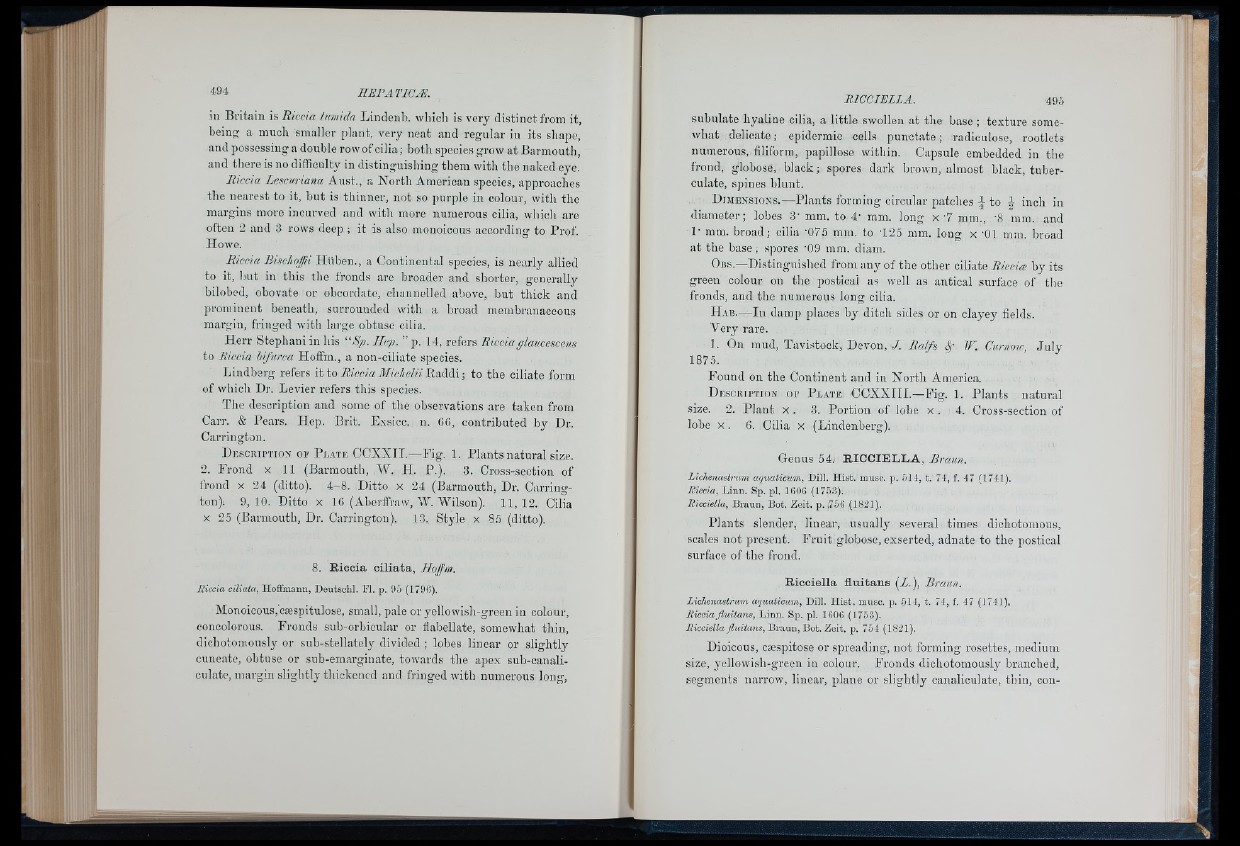
in Britain is Riccia hmnda Lindenb. wliich is very distinct from it,
being a much smaller plant, very neat and regular in its shape,
and possessing a double rowof cilia; both species grow at Barmouth,
and there is no difficulty in distinguishing them with the naked eye.
Riccia Lescm-iana Aust., a North American species, approaches
the nearest to it, but is thinner, not so purple in colour, with the
margins more incurved and with more numerous cilia, which are
often 2 and 3 rows deep ; it is also monoicous according to Prof.
Howe.
Riccia Biscitoßi Hüben., a Continental species, is nearly allied
to it, lint in this tlie fronds are broader and shorter, generally
bilobed, obovate or obcordate, channelled above, but thick and
prominent beneath, surrounded with a broad membranaceous
margin, fringed with large obtuse cilia.
Herr Stephani in his “Sp. Hep. ” p. 14, refers Riccia glaucescens
to Riccia bifurca Hoffm., a non-ciliate species.
Lindberg refers it to Riccia Miehelii R-xMi; to the ciliate form
of wliioh Dr. Levier refers this species.
The de,scription and some of the observations are taken from
Carr. & Pears. Hep. Brit. Exsicc. n. GG, contributed by Dr.
Carrington.
Description oe P late CCXXII.—Pig. 1. Plants natural size.
2. Frond x 11 (Barmoutli, W. H. P.). 3. Cross-section of
frond X 24 (ditto). 4-8. Ditto x 24 (Barmouth, Dr. Carrington):
9, 10. Ditto X 16 (Aberffraw, W. Wilson). 11, 12. Cilia
X 25 (Barmouth, Dr. Carrington). 13. Style x 85 (ditto).
8. Riccia ciliata, Hojfm.
Tticcia ciliala, Hoffmann, Deutschl. Fl, p. 95 (179G).
Monoicous,'cæspitulose, small, pale or yellowish-green in colour,
concolorous. Fronds sub-orbicular or ilabellate, somewhat thin,
dichotomously or sub-stellately divided ; lobes linear or slightly
cuneate, obtuse or siib-emargiiiate, towards the apex sub-canaliculate,
margin slightly thickened and fringed with numerous long,
subulate hyaline cilia, a little swollen at the base ; texture somewhat
delicate; epidermic cells punctate; radiculose, rootlets
numerous, filiform, papillose within. Capsule embedded in the
frond, globo.se, black ; spores dark brown, almost black, tuberculate,
spines blunt.
D imensions.—Plants forming circular patclies J to ) inch in
diameter; lobes 3' mm. to 4’ mm. long x 7 mm,, ’8 mm. and
1- mm. broad; cilia '075 mm. to T25 mm. long x '01 mra. broad
at the base ; spores ’09 mm. diam.
Obs.—Distinguished from any of the other ciliate Riccioe by its
green colour on the postical as well as antical surface of the
fronds, and the numerous lonir cilia.
H a b.— In damp places by ditch sides or on clayey fields.
Very rare.
]. On mud, Tavistock, Devon,/: Ralfs fl IF. Curnow, July
1875.
Found on the Continent and in North America.
Description oe P late CCXXIIL—Fig. 1. Plants natural
size. 2. Plant x . 3. Portion of lobe x . 4. Cross-section of
lobe x . 6. Cilia x (Lindenherg).
Genus 54. RICCIELLA, Braun.
Liehenastrum aquaticum, Dill. Hist. muse. p. 514, t. 74, f. A l (1741).
Riccia, Linn. Sp. pl. 1600 (1753).
Ricciella, Braun, Bot. Zeit, p. .756 (1821).
Plants slender, linear, usually several times dichotomous,
scales not present. Fruit globose, exserted, adnate to the postical
surface of the frond.
Ricciella fluitans (Z,), Braun.
Liehenastrum arjuaticnm, Dill. H is t. nmsc. p. 514, t. 74, f. 47 (1741).
Riccia flu ita n s , Linn. Sp. pl. IGOG (1753).
Ricciella fluitans, Braun, Bot. Zeit. p. 754 (1821).
Dioicous, cæspitose or spreading, not forming rosettes, medium
size, yellowish-green in colour. Fronds diohotomously branohed,
segments narrow, linear, plane or slightly canaliculate, thin, con